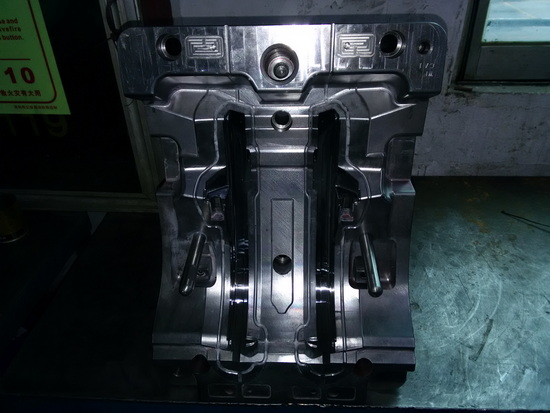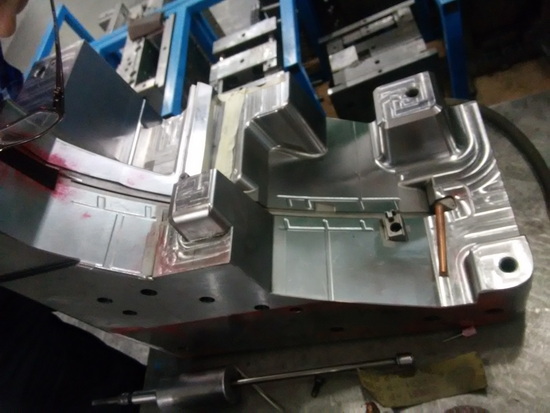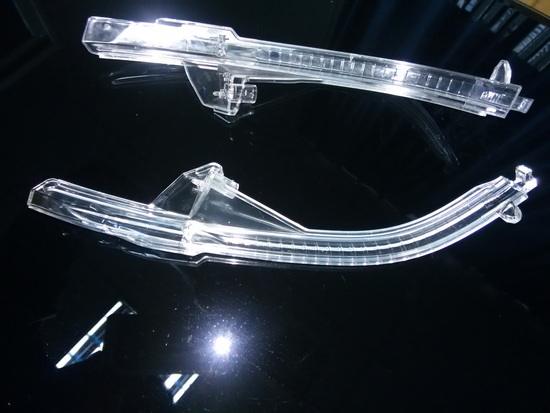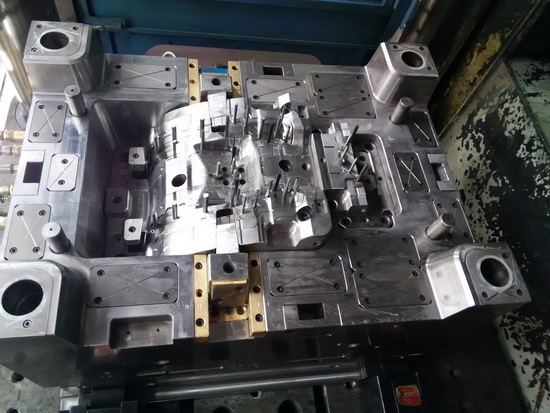塑胶模具省模具体方式简介
Polishing is a very important process in the process of mold making, and it is also the final work. With the wide application of plastic products, the requirements for the appearance quality of plastic products are also getting higher and higher, so the surface polishing of plastic mold cavity The quality should also be improved accordingly, especially the molds with mirror and high-gloss surfaces have higher requirements on the surface roughness of the mold, so the requirements for polishing are also higher. Polishing not only increases the beauty of the workpiece, but also improves the corrosion resistance and wear resistance of the material surface, and can also facilitate subsequent injection molding processes, such as making plastic products easier to demould and reducing production injection molding cycles.
The most commonly used polishing methods are as follows:
(i) Mechanical polishing;

Mechanical polishing is a polishing method in which a smooth surface is obtained by cutting and plastic deformation of the surface of the material to remove the polished convex part. Generally, whetstone strips, wool wheels, sandpaper, etc. are used. Using auxiliary tools such as turntables, ultra-fine grinding and polishing methods can be used for those with high surface quality requirements. Ultra-precision grinding and polishing is a special abrasive tool, which is pressed on the surface of the workpiece to be machined in the grinding and polishing liquid containing abrasive, and rotates at high speed. Using this technology, the surface roughness of Ra0.008μm can be achieved, which is the highest among various polishing methods. Optical lens molds often use this method.
⑴Basic procedures of mechanical polishing In order to obtain high-quality polishing results, the most important thing is to have high-quality polishing tools and auxiliary materials such as oilstone, sandpaper and diamond abrasive paste. The choice of polishing program depends on the surface condition after pre-processing, such as machining, EDM, grinding and so on. The general process of mechanical polishing is as follows:
①The surface after rough polishing by milling, electric spark, grinding and other processes can be polished by a rotating surface polishing machine or an ultrasonic grinding machine with a rotating speed of 35 000-40 000 rpm. The commonly used method is to use a wheel with a diameter of Φ3mm and WA # 400 to remove the white EDM layer. Then there is manual whetstone grinding, strip whetstone with kerosene as a lubricant or coolant. The general order of use is #180 ~ #240 ~ #320 ~ #400 ~ #600 ~ #800 ~ #1000. Many moldmakers choose to start with #400 to save time.
②Semi-fine polishing and semi-fine polishing mainly use sandpaper and kerosene. The numbers of sandpaper are: #400 ~ #600 ~ #800 ~ #1000 ~ #1200 ~ #1500. In fact, #1500 sandpaper is only suitable for hardening die steel (above 52HRC), not for pre-hardened steel, because it may cause the surface of pre-hardened steel to burn.
③ Fine polishing and fine polishing mainly use diamond grinding paste. If a polishing cloth wheel is used to mix diamond grinding powder or grinding paste for grinding, the usual grinding order is 9μm (#1800) ~ 6μm (#3000) ~ 3μm (#8000). 9μm diamond paste and polishing cloth wheels can be used to remove hair-like scratches left by #1200 and #1500 sandpapers. Then polish with sticky felt and diamond abrasive paste, in the order of 1 μm (#14000) ~ 1/2 μm (#60000) ~ 1/4 μm (#100000). The polishing process with precision requirements of more than 1μm (including 1μm) can be carried out in a clean polishing chamber in the mold processing workshop. For more precise polishing, an absolutely clean space is required. Dust, fumes, dandruff and drool all have the potential to undo the high-precision polished finish you get after hours of work.
(2) Skills in mechanical polishing

Ⅰ When polishing with sandpaper, the following points should be noted:
① Polishing with sandpaper requires the use of soft wooden sticks or bamboo sticks. When polishing a circular or spherical surface, use a cork stick to better match the curvature of the circular and spherical surfaces. A harder wood, like cherry, is more suitable for polishing flat surfaces. Trimming the end of the wooden strip to keep it consistent with the shape of the steel surface can prevent the sharp angle of the wooden strip (or bamboo strip) from contacting the steel surface and causing deep scratches.
②When changing to a different type of sandpaper, the polishing direction should be changed from 45° to 90°, so that the streak shadow left by the previous type of sandpaper after polishing can be distinguished. Before changing different types of sandpaper, you must carefully wipe the polished surface with 100% pure cotton dipped in a cleaning solution such as alcohol, because a small grit left on the surface will destroy the entire subsequent polishing work. This cleaning process is just as important when switching from sandpaper to diamond paste polishing. All particles and kerosene must be completely cleaned before polishing can proceed.
③In order to avoid scratching and burning the surface of the workpiece, special care must be taken when polishing with #1200 and #1500 sandpaper. It is therefore necessary to apply a light load and polish the surface using a two-step polishing method. When polishing with each type of sandpaper, it should be polished twice in two different directions, with a rotation of 45°~90° each time between the two directions.
Ⅱ Diamond grinding and polishing should pay attention to the following points:

(1) This polishing must be carried out under lighter pressure as much as possible, especially when polishing pre-hardened steel parts and polishing with fine abrasive paste. When polishing with #8000 abrasive paste, the common load is 100~200g/cm2, but it is difficult to maintain the accuracy of this load. To make this easier, make a thin, narrow handle on the wood strip, such as adding a piece of copper; or cut a portion of the bamboo strip to make it softer. This helps control the polishing pressure to ensure that the mold surface pressure is not too high.
(2) When using diamond grinding and polishing, not only the work surface is required to be clean, but the hands of the worker must also be carefully cleaned
(3) Each polishing time should not be too long, the shorter the time, the better the effect. “Orange peel” and “pitting” will occur if the polishing process is carried out for too long.
(4) In order to obtain a high-quality polishing effect, polishing methods and tools that are prone to heat should be avoided. For example: polishing the polishing wheel, the heat generated by the polishing wheel can easily cause “orange peel”. When the polishing process is stopped, it is very important to keep the surface of the workpiece clean and carefully remove all abrasives and lubricants, and then spray a layer of mold anti-rust coating on the surface. Since mechanical polishing is mainly done manually, polishing technology is still the main reason for affecting polishing quality. In addition, it is also related to the mold material, the surface condition before polishing, and the heat treatment process. High-quality steel is a prerequisite for obtaining good polishing quality. If the surface hardness of the steel is uneven or the characteristics are different, polishing difficulties often occur. Various inclusions and pores in the steel are not conducive to polishing.
(5) The effect of different hardness on the polishing process The increase in hardness increases the difficulty of grinding, but the roughness after polishing decreases. As the hardness increases, the polishing time required to achieve lower roughness increases accordingly. At the same time, the hardness increases, and the possibility of over-polishing is correspondingly reduced.
(6) The influence of the surface condition of the workpiece on the polishing process During the crushing process of the steel, the surface layer will be damaged due to heat, internal stress or other factors. Improper cutting parameters will affect the polishing effect. The surface after EDM is more difficult to grind than the surface after ordinary machining or heat treatment, so precision EDM should be used before the end of EDM, otherwise the surface will form a hardened thin layer. If the EDM finishing specification is not properly selected, the depth of the heat-affected layer can be up to 0.4mm. The hardened thin layer is harder than the matrix and must be removed. Therefore, it is best to add a rough grinding process to completely remove the damaged surface layer to form an average rough metal surface, which provides a good foundation for polishing.

The polishing in plastic mold processing is very different from the surface polishing required in other industries. Strictly speaking, the polishing of the mold should be called mirror processing. It not only has high requirements for polishing itself but also high standards for surface flatness, smoothness and geometric accuracy. Surface polishing is generally only required to obtain a bright surface. The standard of mirror processing is divided into four grades: AO=Ra0.008μm, A1=Ra0.016μm, A3=Ra0.032μm, A4=Ra0.063μm, it is difficult to precisely control the geometric accuracy of parts due to electrolytic polishing, fluid polishing and other methods However, the surface quality of chemical polishing, ultrasonic polishing, magnetic polishing and other methods cannot meet the requirements, so the mirror surface processing of precision molds is still dominated by mechanical polishing.